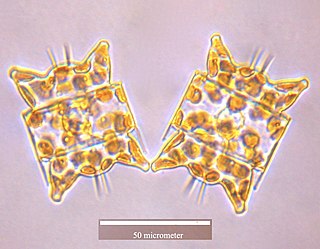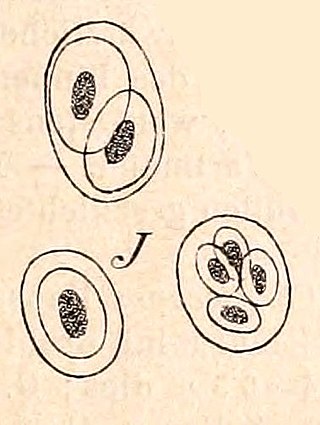
Fragilariophyceae is a group of pennate diatoms lacking a raphe.

Hemerophanes is a genus of moths in the subfamily Lymantriinae. The genus was erected by Cyril Leslie Collenette in 1953.

Himanthalia elongata is a brown alga in the order Fucales, also known by the common names thongweed, sea thong and sea spaghetti. It is found in the north east Atlantic Ocean and the North Sea.

Odontella is a genus of marine diatoms. Some sources place it in the family Triceratiaceae, others in the family Odontellaceae. It contains the following species:
Sycacantha is a genus of moths belonging to the subfamily Olethreutinae of the family Tortricidae.
Bangia is an extant genus of division Rhodophyta that grows in marine or freshwater habitats. Bangia has small thalli with rapid growth and high reproductive output, and exhibits behavior characteristic of r-selected species. The plants are attached by down-growing rhizoids, usually in dense purple-black to rust-colored clumps. The chloroplasts of Bangia, like others in the division Rhodophyta, contain chlorophyll a and sometimes chlorophyll d, as well as accessory pigments such as phycobilin pigments and xanthophylls. Depending on the relative proportions of these pigments and the light conditions, the overall color of the plant can range from green to red to purple to grey; however, the red pigment, phycoerythrin, is usually dominant.
Events from the year 1834 in Denmark.
Events from the year 1782 in Denmark.
Hans Christian Lyngbye was a Danish priest and botanist, specialising in algae.

Lyngbya majuscula is a species of filamentous cyanobacteria in the genus Lyngbya. It is named after the Dane Hans Christian Lyngbye.

Fragilaria is a genus of freshwater and saltwater diatoms. It is usually a colonial diatom, forming filaments of cells mechanically joined by protrusions on the face and in the center of their valves. The individual diatoms appear swollen in their centers where they are joined to the colonial ribbon. The genus grows as both plankton and benthic species, free living in colonies or as epiphytes. Some species are bloom forming diatoms in eutrophic lakes. The type species is Fragilaria pectinalis Lyngbye from designating a lectotype from Conferva pectinalis O.F.Müller. The taxonomy of the genus is still uncertain.
Sinanas is a genus of prehistoric duck that lived during the middle Miocene. The single known species is Sinanas diatomas. Fossils of the species have been recovered from the Shandong Province of China. Taxonomists are uncertain as to its affinities to modern waterfowl.

Bangiaceae is a family of red algae in the order Bangiales. It contains laver, used to make laverbread, and various species in the genus of Pyropia are used to make nori.

Hans Peter Johan Lyngbye was a Danish businessman.

Gloeothece is a genus of cyanobacteria belonging to the family Aphanothecaceae.

Sphacelariaceae is a family of algae belonging to the order Sphacelariales.
Halidrys is a genus of brown algae belonging to the family Sargassaceae.

Didymosphenia is a genus of diatoms belonging to the family Cymbellaceae.

Callithamnion is a genus of algae belonging to the family Callithamniaceae.
Sphacelaria is a genus of brown macroalgae in the family Sphacelariaceae.












